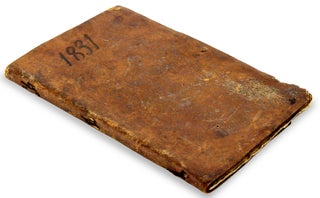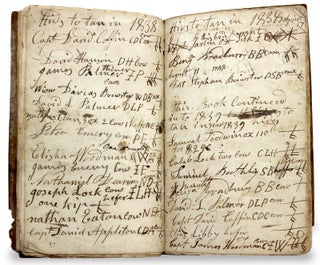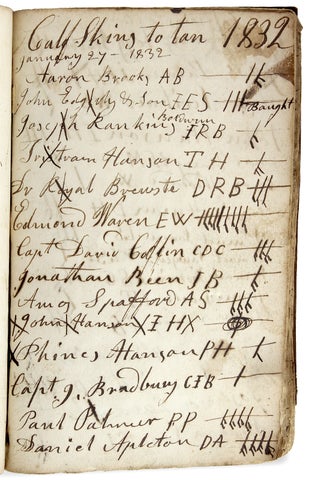1830–1839 New England Leather Tanner’s Manuscript Notebook.
With the name of each supplier accompanied by stylized, branding iron-like initials and tally marks
Leather tanner’s notebook recording a variety of animal skins received and from whom received during six years in the 1830s. Calfskins are dominant; often recorded in separate lists wherein the name of each supplier is accompanied by stylized, branding iron-like initials and tally marks. These initials may distinguish the hides taken in on commission, then returned to the client.
The tanner is not identified, but the predominantly English names and the mention of several “Capt[ains].” suggest a port city or a town near a port, possibly in New England, perhaps Maine.
The notebook was kept from 1830 to 1832 and again from 1837 to 1839. For most of these individual years there appear to be multiple sections recording hides and skins received, skins to tan, and skins bought. This may suggest the tanner was tanning on commission for clients as well as tanning on speculation for himself.
The types of skins include cow, bull, calf, ox, “hefer” or heifer, “stear” or steer, hog, “Chuck” [woodchuck?] horse, and sheep.
A cursory check of some names suggests the possibility the tanner was located in Maine. Some of these names include Capt. James Codman, Capt. James Woodman, Capt. Daniel Appleton, and Dr. Stephen C. Brewster. One name within, that of William Meserve, is identified by a place name: Limington, likely Limington, Maine. Other names seen within seem to point elsewhere and include Dr. Royal Brewster, possibly of Boston and Capt. David Coffin, possibly of Nantucket.
Tally marks and types of animal skins accompany most names. Sometimes Arabic numbers appear to give item counts, other times weights in pounds. In a few places these numbers refer to pages, perhaps in an account book or ledger. The numbers here do not appear to be recording prices.
The notebook provides a good example of systematic record keeping and offers the potential for researching a web of suppliers and clients of a thriving, possibly New England tannery in the 1830s.
Description: 1830–1839 New England Leather Tanner’s Manuscript Notebook.
[Likely Maine]. 1830–1832; 1837–1839. [42]ff., approx. [48] pp. written in ink. Flexible calf covers; hand-sewn with rawhide. 6 x 4 inches. Minor losses to covers; some soiling and toning; very good.
[3726333]Sold

![[3726333] 1830–1839 New England Leather Tanner’s Manuscript Notebook. Unk.](https://rareamericana.cdn.bibliopolis.com/pictures/3726333.jpg?width=768&height=1000&fit=bounds&auto=webp&v=1531245208)


